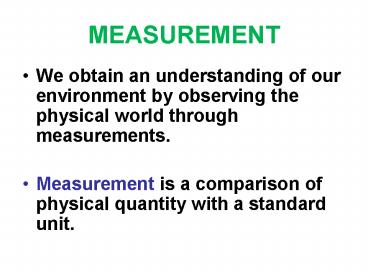MEASUREMENT - PowerPoint PPT Presentation
1 / 24
Title:
MEASUREMENT
Description:
Arial Symbol Book Antiqua Default Design MEASUREMENT MEASUREMENT FUNDAMENTAL QUANTITIES Length Time Mass Electric Charge STANDARD UNITS British System Metric ... – PowerPoint PPT presentation
Number of Views:47
Avg rating:3.0/5.0
Title: MEASUREMENT
1
MEASUREMENT
- We obtain an understanding of our environment by
observing the physical world through
measurements. - Measurement is a comparison of physical quantity
with a standard unit.
2
MEASUREMENT
- It is expressed with numbers and units.
- Physical characteristics can be expressed in
terms of fundamental quantities. - Our comprehension of the physical world is based
on fundamental quantities.
3
FUNDAMENTAL QUANTITIES
- Four quantities have been identified and
specified as - fundamental.
- These are
- Length
- Mass
- Time
- Electric charge
- They form the basis for other quantities
- necessary to describe and understand the
- physical sciences.
4
Length
- We use length to measure location or size.
- Length is defined as the measurement of space in
any direction. - Note Space has three dimensions, each is
measured by length. - Consider a box
- Length (l)
- Width (w)
- Height (h)
5
Time
- Time is the continuous forward flow of events.
- Events allow us to precise time, without events,
we have no innate awareness of time.
6
Mass
- Mass quantifies matter.
- Mass refers to the amount of matter an object
contains.
7
Electric Charge
- Electric Charge is the property associated with
some particles, that gives rise to electric
forces and electrical phenomena.
8
STANDARD UNITS
- A standard unit is a fixed and reproducible value
for the purpose of taking accurate measurements. - A set of standard units is referred to as a
system of units.
9
British System
- British System uses the familiar unit of
- Length foot
- Mass Slug
- Weight pound
- Time Second
- Electric Charge Coulomb
- Note It is also called the Gravitational System
of Units.
10
Metric System
- Metric System is considered to be simpler
- than the British System as the conversion is by a
- factor of ten.
- The standard units of
- Length meter, m
- Mass kilogram, kg
- Time seconds, s
- Electric Charge Coulomb
- They are called the International System of Units
(SI - units).
11
Systems of units
- Metric System
- Length meter, m
- Mass kilogram, kg
- Time seconds, s
- Electric Charge - Coulomb
- British System
- Length foot
- Mass Slug
- Time Second
- Electric Charge Coulomb
- Weight pound
12
International System of Units
- There are seven base units of the International
- System of Units.
- Meter, m, measures length.
- Kilogram, kg, measures mass.
- Second, s, measures time.
- Ampere, A, measures electric current.
- Kelvin, K, measures temperature.
- Mole, mol, measures amount of substance.
- Candela, cd, measures luminous intensity.
13
Derived Quantities
- Derived Quantities are formed by combining two or
more of the fundamental quantities. - Examples
- Area length x width
- Volume length x width x height
- Speed distance/time
- Density mass/volume
14
Density
- Density refers to how compact or crowded a
- substance is, that is, the amount of mass
- located in a definite volume.
- Density is simply the mass per unit volume.
- Density mass/volume
15
Measurement Errors
- Systematic Errors
- Systematic errors are associated with instruments
or the technique used. - They are as a result of
- Improperly calibrated instrument
- Error incurred from observers reading
16
Measurement Errors
- Random Errors
- Random Errors result from unknown and
unpredictable variations in experimental
situations. - Such as fluctuation in electrical voltage.
- Changes in temperature, pressure, etc
17
Accuracy / Precision
- Accuracy indicates how close measurement comes to
the true value. - Precision refers to the agreement among repeated
measurement, that is, how close they are
together.
18
Converting Quantities
- Use a conversion factor, a ratio relating
- one unit to another.
- Choose the appropriate form of the conversion
factor(s) so that the unwanted units cancel. - 3. Check to see that the unit cancel and that
- you obtain the desired unit.
19
Converting Quantities
- Desired quantity and units given
- quantity and units x conversion factor
20
Common relationships
- 1 kg 2.2 lbs.
- 1 lb. 453.6 g
- 1 inch 2.54 cm
- 1.06 qt 1 L
- 1.0 mile 1.609 km
21
Temperature
- A measure of hotness or coldness of an
- object .
- Types of temperature scales
- Fahrenheit on this scale the normal freezing and
boiling points of water are taken to be 32?F and
212?F respectively. - Celsius Boiling point is 100?C and the freezing
point is 0?C
22
0ºC 32ºF
32ºF
0ºC
23
100ºC 212ºF
0ºC 32ºF
0ºC
100ºC
212ºF
32ºF
24
Relationship Between oC and oF
oF 1.8 oC 32
- There is no direct relationship between K
- and oF. Therefore, one must go through oC
- in order to get temperature in K.
K oC 273































